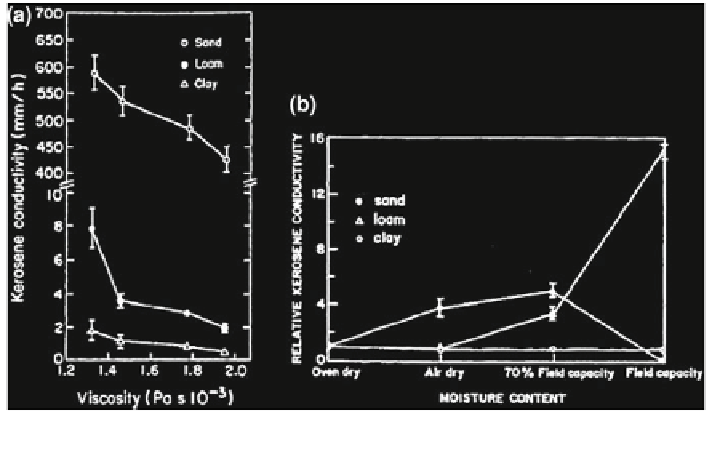Geoscience Reference
In-Depth Information
Fig. 12.47
Kerosene conductivity as affected by a viscosity and b soil moisture content (Gerstl
et al.
1994
)
field capacity. No kerosene flow was observed in the clay soils from oven-dried to
field capacity moisture contents.
These behaviors can be explained as follows. First, the decrease in kerosene
conductivity in sand is caused by a mechanically induced change in the original
porosity, which occurs during leaching to reach a field capacity moisture content.
In the loamy soils, the porosity of the system is hardly affected, as the moisture
content increases toward field capacity, and instead, there is a reduced resistance to
the flow of kerosene. This phenomenon flow can be attributed to the Yuster effect
(Rose
1993
), which is a lubrication effect occurring when a thin layer of water
coats the surface, thus reducing the resistance to flow and preventing interaction
between the solid phase and kerosene molecules. When the loamy soil is oven-
dried, kerosene infiltrating into the soil is adsorbed on the pore surfaces, creating a
wall effect that retards movement by formation of a viscous layer. The kerosene
conductivity is not changed in clay soils, regardless of the moisture content. Ini-
tially, when the soil humidity ranges between oven-dried and air-dried, kerosene
adsorption on the surface of the solid material controls its flow, and subsequent
pores plugging by water impede the kerosene flow.
Retention in Porous Media As NAPL migrates through the subsurface, some
of it becomes entrapped according to its retention capacity. In addition, NAPL
constituents may become redistributed in the gaseous phase.
The extent of kerosene trapping was determined quantitatively in a series of
laboratory and outdoor experiments with Swedish soils (Jarsjo et al.
1994
),
yielding an empirical equation for the kerosene residual content as a function of
soil composition:

